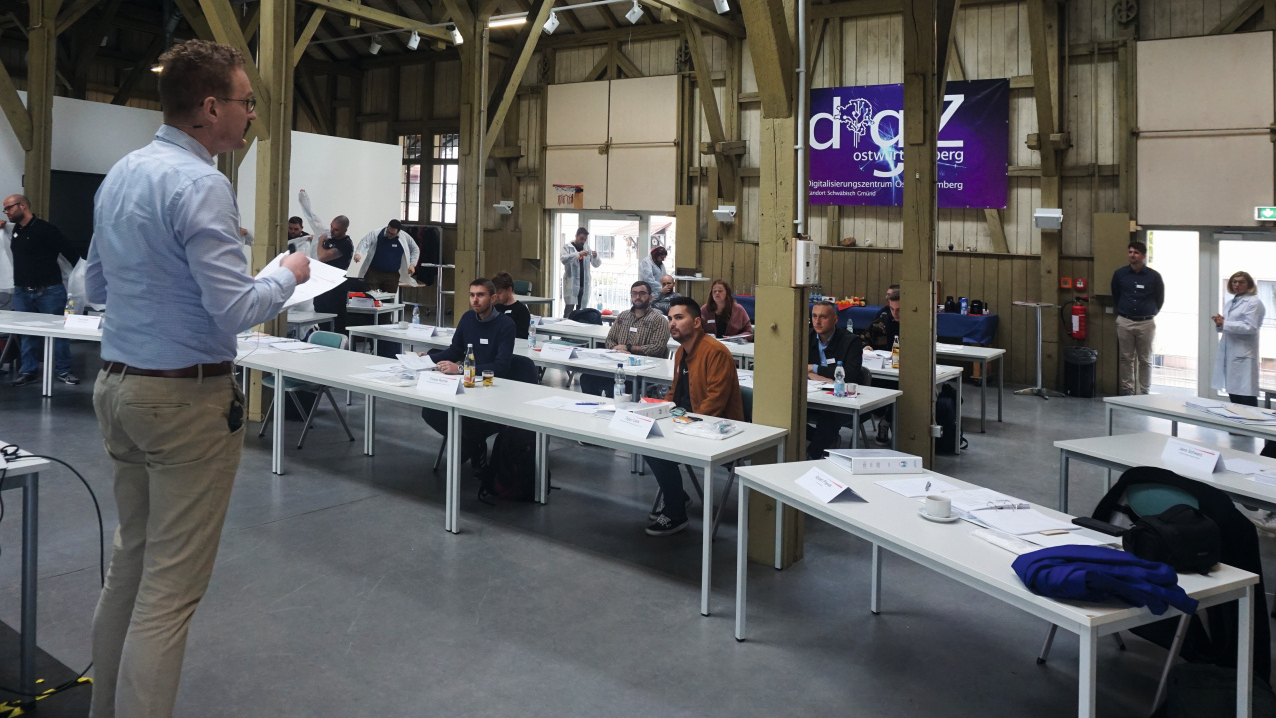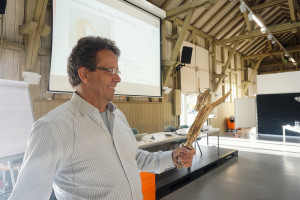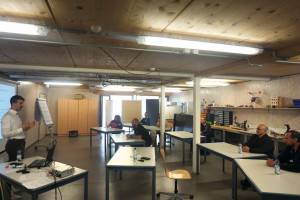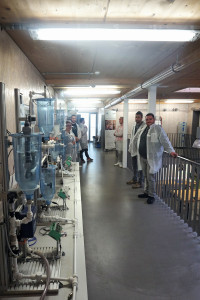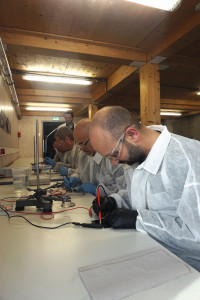The Center for Surface Technology (Z.O.G.) in Schwäbisch Gmünd is the first port of call for newcomers to the industry. In a thoroughly orchestrated crash course, participants learn everything they need to know about electroplating technology in three days and also look beyond their own nose. A field report.
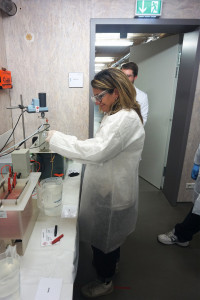 Mission accomplished: Freshly electroplated, the golden spoon comes out of the electrolyteTheEULE science workshop in Gmünd aims to get people excited about technology. This November morning was no exception. 25 more or less young people are gathered here, all of whom have one thing in common: They need knowledge of the theory and practice of electroplating. Most of them are newcomers to the industry. There is Alexander, for example, who recently took over the management of an electroplating company. Or Patrick, who works on the bath at home in the Rhineland and hopes to gain knowledge of chrome-plating rollers from the course. Martin is fresh out of university and has been sent here by his new employer, a supplier to the industry, to get an overview of the field. And then there's me - a trade magazine journalist with a new subject. The list of stories that can be told here is long. But I want to focus on this seminar in particular - what it does, how it feels, what remains and for whom it is intended.
Mission accomplished: Freshly electroplated, the golden spoon comes out of the electrolyteTheEULE science workshop in Gmünd aims to get people excited about technology. This November morning was no exception. 25 more or less young people are gathered here, all of whom have one thing in common: They need knowledge of the theory and practice of electroplating. Most of them are newcomers to the industry. There is Alexander, for example, who recently took over the management of an electroplating company. Or Patrick, who works on the bath at home in the Rhineland and hopes to gain knowledge of chrome-plating rollers from the course. Martin is fresh out of university and has been sent here by his new employer, a supplier to the industry, to get an overview of the field. And then there's me - a trade magazine journalist with a new subject. The list of stories that can be told here is long. But I want to focus on this seminar in particular - what it does, how it feels, what remains and for whom it is intended.
Symbol of electroplating: the golden spoon
After welcoming everyone, course leader and Umicore sales representative Erich Arnet, also known as Mister ZOG, steps in front of the tables arranged in a semi-circle. He begins with Luigi Galvani's discovery of "animal electricity", which dates back to 1789. During the historical review, he looks from one participant to the next, pauses as if to give the audience the opportunity to let what they have heard sink in, and then continues calmly in a light Swiss dialect. The importance of technology is illustrated with examples: kilometers of galvanized current-carrying cables run in cars, we learn, and aircraft landing gear is technically functionalized with chrome coatings. This is followed by a look at the 16 metals that are suitable for electroplating or metallization; at rectifiers that convert electrical energy into chemical energy and thus cause the deposition; at metal salts and the development of hydrogen in the process. Heads are quickly spinning, but after every 30 minutes the lecturers and the topic change. Erich Arnet is followed by Benjamin Wieser, whose main job is also at Umicore, and after another half an hour, we aspirants to electroplating expertise find ourselves in a small training room on the upper floor. In front of us is Fabian Schäfer, who is teaching coating systems and combinations. The participants have been divided into three groups in advance, which are now being taught in the laboratory, in the main room or here. Then, just before the lunch break, one of the highlights: Guided by lecturer Inge Baumann - who is an electroplating technician and master electroplater at Umicore - everyone is now supposed to gild their own proverbial golden spoon. Wearing lab coats, protective goggles and gloves, we get to work: the simple household spoon is rinsed, decapitated and then placed in the gold electrolyte. Finally, we hold the good piece in our hands, which makes us feel like junior electroplaters for the first time.
A sumptuous lunch is served in the Forum restaurant inside a huge yellow-gold cube not far from the workshop. The cube gets its color from the anodized aluminium plates that surround the building, as we learn on the way there. A view of the world through the eyes of an electroplater.
On the sidelines of the meal, we talk to Fabian Schäfer, who is joining us as a lecturer for the first time. As I find out later from Erich Arnet, he was the best student in his year and studied under Prof. Timo Sörgel at Aalen University. He is now at Carl Zeiss Jena and is part of the winning team of the Future Prize for a particularly sophisticated and powerful microscope. In other words, the man is first-class, as is his fellow lecturer Robin Arnet, who recently received the Heinz-Leuze Prize in Leipzig for his contribution to a publication on silver dispersion layers with self-lubricating properties. The three practitioners Wieser, Baumann and Arnet from Umicore then complete the team of lecturers with the necessary experience. Sounds like a promising teaching concept.
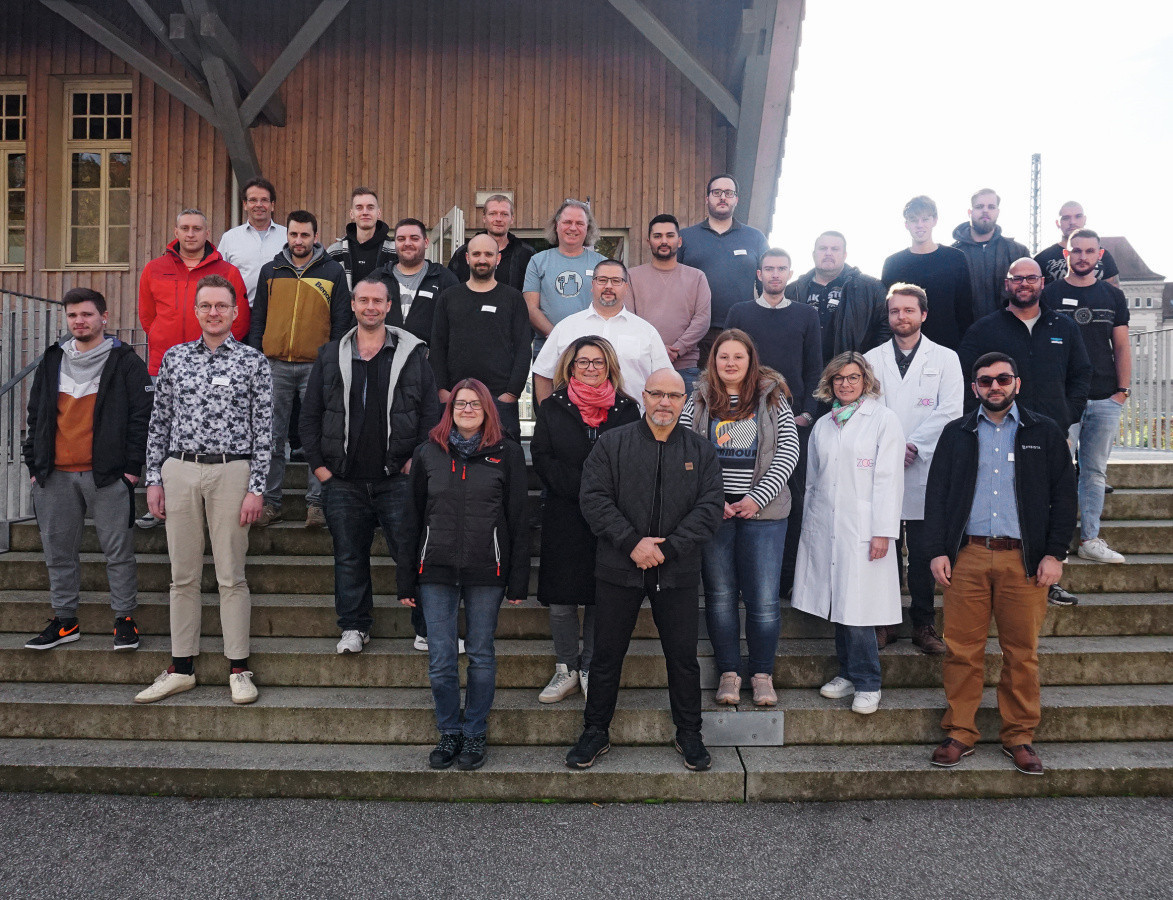 Tackling the future with fresh knowledge: Young electroplaters and lecturers at the end of the course
Tackling the future with fresh knowledge: Young electroplaters and lecturers at the end of the course
A new look at an old acquaintance
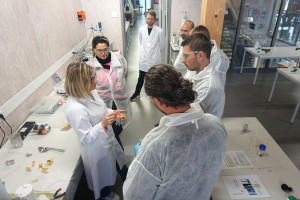 An electroform is created: Inge Baumann explains the principleTheride through the world of electroplating continues in the afternoon: it's all about zinc and other non-precious metals. I already got to know zinc die casting in my last life as an industrial editor in the foundry industry. Now I'm learning more about the casting material for which pre-treatment is crucial for successful coating, which can be chromated and passivated and is often coated with nickel, iron and tin to protect it from corrosion. As I learn, my old material acquaintance zinc is omnipresent in everyday life: not so much as part of the electroplating process, but as hot-dip galvanizing on railings, lanterns and all kinds of metal components that are exposed to the weather. There is time for questions at the end of each lesson. Patrick wants to reduce scrap in roller chrome plating. In the meantime, we have learned that chrome has a very poor metal yield during deposition and that a lot of energy is required to chrome plate surfaces evenly. Patrick chromes in a vertical electroplating bath and wonders how the anodes need to be optimally positioned to achieve a better result. Solutions are suggested all around, experiences are pooled and knowledge is gathered (by the way, the chrome reference book from Leuze-Verlag offers solutions). At the end of the day, my repertoire of knowledge about this technology has increased significantly. The many mysteries surrounding the smoking baths and the magical processes that take place in them in electroplating are gradually becoming clearer: Alchemy becomes science.
An electroform is created: Inge Baumann explains the principleTheride through the world of electroplating continues in the afternoon: it's all about zinc and other non-precious metals. I already got to know zinc die casting in my last life as an industrial editor in the foundry industry. Now I'm learning more about the casting material for which pre-treatment is crucial for successful coating, which can be chromated and passivated and is often coated with nickel, iron and tin to protect it from corrosion. As I learn, my old material acquaintance zinc is omnipresent in everyday life: not so much as part of the electroplating process, but as hot-dip galvanizing on railings, lanterns and all kinds of metal components that are exposed to the weather. There is time for questions at the end of each lesson. Patrick wants to reduce scrap in roller chrome plating. In the meantime, we have learned that chrome has a very poor metal yield during deposition and that a lot of energy is required to chrome plate surfaces evenly. Patrick chromes in a vertical electroplating bath and wonders how the anodes need to be optimally positioned to achieve a better result. Solutions are suggested all around, experiences are pooled and knowledge is gathered (by the way, the chrome reference book from Leuze-Verlag offers solutions). At the end of the day, my repertoire of knowledge about this technology has increased significantly. The many mysteries surrounding the smoking baths and the magical processes that take place in them in electroplating are gradually becoming clearer: Alchemy becomes science.
The group finally comes together for dinner at the Alpenwirtshaus. The Bavarian restaurant is located directly on the market square, which is lined with magnificent half-timbered houses and adorned with a Renaissance Marienbrunnen fountain in the middle. Splendor meets hearty cuisine. A perfect mix to prepare us for the intellectual fare of the day ahead.
The physics of splendor
Because then it's straight back to the full. In the overview of non-precious metal electrolytes with Benjamin Wieser, we learn that sometimes you can do without electricity. Electroless nickel is deposited on the substrate completely without electricity using only phosphorus and sodium hypophosphite as a reducing agent, and the metal distribution is even more even. But nothing comes from nothing. A bath temperature of 60 degrees is required to increase reactivity, which, together with higher chemical, waste water and disposal costs, makes the process very cost-intensive. We continue with Robin Arnet, who makes his first appearance in the course and explains gloss and leveling. I had never thought about the fact that, according to physics, gloss only occurs on surfaces whose surface roughness is smaller than the wavelength of light - i.e. on smooth surfaces. The topic of leveling also offers impressive surprises. For example, we learn that chemical bath additives give the tips of uneven areas on the surface a positive charge, which means that no material is deposited there. Instead, the deeper areas of the surface are filled - resulting in leveling. Small tricks with a big effect.
The bronze statues from Tuscany
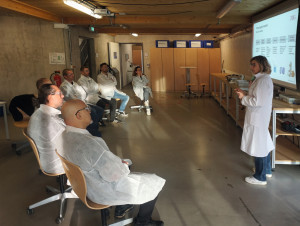 Final spurt at the ZOG: the topic of tampon electroplating is on the agendaArather long block on bronze follows. The alloy of copper and tin has been known since the Bronze Age, which began over 4000 years ago. The famous Nebra Sky Disk, the oldest known depiction of the heavens, also dates from this period. Even more exciting, because they are more recent, are the discoveries that were recently made in a thermal bath in Tuscany and are of course an immediate topic here at the basic electroplating course in Schwäbisch Gmünd: 24 thousand-year-old bronze statues that are still in perfect condition. Mud and water have protected this treasure from antiquity. However, the precious metal is generally extremely resistant to corrosion on its own, as Robin tells us, referring to the patina, an oxide layer that copper-containing objects form on their own and which virtually heals itself.
Final spurt at the ZOG: the topic of tampon electroplating is on the agendaArather long block on bronze follows. The alloy of copper and tin has been known since the Bronze Age, which began over 4000 years ago. The famous Nebra Sky Disk, the oldest known depiction of the heavens, also dates from this period. Even more exciting, because they are more recent, are the discoveries that were recently made in a thermal bath in Tuscany and are of course an immediate topic here at the basic electroplating course in Schwäbisch Gmünd: 24 thousand-year-old bronze statues that are still in perfect condition. Mud and water have protected this treasure from antiquity. However, the precious metal is generally extremely resistant to corrosion on its own, as Robin tells us, referring to the patina, an oxide layer that copper-containing objects form on their own and which virtually heals itself.
I also remember from that day the section on anodizing, in which an anodic protective layer is created on the surface of aluminium components such as the aluminium plates on the restaurant cube. The component, which is actually the cathode, is anodized, which transforms the top metal layer into a corrosion-resistant oxide. At the same time, the porous aluminum surface is suitable for coloring, as the pores can be filled with dye. By dipping the component in hot water, the color can be sealed easily and inexpensively because aluminum oxide then swells. Miracles of technology that are more valuable than ever in view of the increasing use of the light metal in vehicle construction, for example. For the electroplating of aluminium, the oxide layer is admittedly rather troublesome and requires extensive pre-treatment, often with zincate pickling.
But despite all the theory, there is no shortage of practical exercises on day 2. Now on the agenda: an excursion into electroforming, during which Inge Baumann presents us with a gold-plated coffee filter and electroformed jewelry and then asks us again to put on lab coats and other protective accessories. Now it's time to gild little plastic animals - electroforms. The crux of the matter: plastic is not conductive and this is precisely what is crucial in electrolytic electroplating in order to deposit layer after layer with the help of an electric current. We eliminate the deficit with a silver lacquer and then continue as learned. Soon my originally matt dark plastic sheep shines in glistening gold. After further theoretical teaching episodes on corrosion (annual damage in the three-digit billion range, estimated at 6% of GDP!) and measuring and testing methods, we conclude this challenging day of instruction.
The course participants through the ages
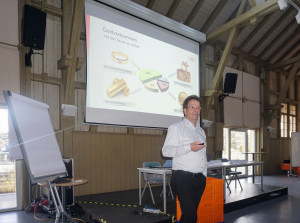 One of the highlights was Erich Arnet's lecture on gold On the evening before the last day of the course, there is traditionally a meeting of all participants and lecturers. In "El Mexikano", a chic restaurant bar with a large selection of cocktails and sumptuous meals, I finally meet Erich Arnet for a one-on-one conversation about the ZOG and himself. There is a long table in the background, where participants and lecturers discuss open questions or chat privately over food and drink in a relaxed atmosphere. Last but not least, a course like this is always a good platform for networking. During the first few sentences of my conversation, a guest in the next room starts singing a well-honed birthday song. The atmosphere is exuberant. I learn that Erich Arnet is Swiss, trained as a chemical laboratory technician and electroplating technician and now works in international sales at Umicore Galvanotechnik. He can be satisfied with the teaching success of the past year. Eight basic courses and seven other seminars have already been held this year, compared to less than half as many otherwise. He cites the pent-up demand caused by the coronavirus pandemic as one of the main reasons for this, as well as the many newcomers to the industry. He, his changing team of speakers and the organizers Ulrike Häfner and Sandra Ettle are the Zentrum für Oberflächentechnik (ZOG). "Without them, nothing would work here," he emphasizes. The background to the ZOG is the industry's interest in training and further education. The ZOG has 60 company members and 120 association members. However, the group of participants has changed in recent years: "We no longer have 10% electroplaters here today, which was very different ten years ago," he says, looking back. Today, the courses are mainly attended by purchasers, developers, managers, production managers and quality assurance staff, he reveals. The short teaching episodes of 30 minutes and the alternation between theory and practice have a system: the courses should be varied and fun. There should also be enough time for questions to discuss everyday problems in electroplating and thus combine theory and practice. In addition to the basic courses, ZOG also offers in-house seminars. Erich Arnet and a team of experts then travel to aircraft builders or electronics manufacturers and teach and advise on site. Arnet's words resonate with enthusiasm. He is wholeheartedly committed to the electroplating cause - and would like his team of lecturers to be as well. As the evening draws to a close, he takes his leave. His BMW motorcycle is waiting outside for the journey home. He and his lecturers are actually on vacation - so they can combine their main job and their teaching profession.
One of the highlights was Erich Arnet's lecture on gold On the evening before the last day of the course, there is traditionally a meeting of all participants and lecturers. In "El Mexikano", a chic restaurant bar with a large selection of cocktails and sumptuous meals, I finally meet Erich Arnet for a one-on-one conversation about the ZOG and himself. There is a long table in the background, where participants and lecturers discuss open questions or chat privately over food and drink in a relaxed atmosphere. Last but not least, a course like this is always a good platform for networking. During the first few sentences of my conversation, a guest in the next room starts singing a well-honed birthday song. The atmosphere is exuberant. I learn that Erich Arnet is Swiss, trained as a chemical laboratory technician and electroplating technician and now works in international sales at Umicore Galvanotechnik. He can be satisfied with the teaching success of the past year. Eight basic courses and seven other seminars have already been held this year, compared to less than half as many otherwise. He cites the pent-up demand caused by the coronavirus pandemic as one of the main reasons for this, as well as the many newcomers to the industry. He, his changing team of speakers and the organizers Ulrike Häfner and Sandra Ettle are the Zentrum für Oberflächentechnik (ZOG). "Without them, nothing would work here," he emphasizes. The background to the ZOG is the industry's interest in training and further education. The ZOG has 60 company members and 120 association members. However, the group of participants has changed in recent years: "We no longer have 10% electroplaters here today, which was very different ten years ago," he says, looking back. Today, the courses are mainly attended by purchasers, developers, managers, production managers and quality assurance staff, he reveals. The short teaching episodes of 30 minutes and the alternation between theory and practice have a system: the courses should be varied and fun. There should also be enough time for questions to discuss everyday problems in electroplating and thus combine theory and practice. In addition to the basic courses, ZOG also offers in-house seminars. Erich Arnet and a team of experts then travel to aircraft builders or electronics manufacturers and teach and advise on site. Arnet's words resonate with enthusiasm. He is wholeheartedly committed to the electroplating cause - and would like his team of lecturers to be as well. As the evening draws to a close, he takes his leave. His BMW motorcycle is waiting outside for the journey home. He and his lecturers are actually on vacation - so they can combine their main job and their teaching profession.
"Lots of gold - lots of future"
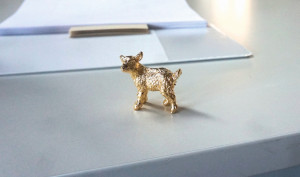 Another exhibit for the collection: matt dark plastic becomes shiny goldAnyone whothinks that the last day of the course is just a formality with certificates and closing speeches is mistaken. The work steps in electroplating remain in focus right to the end: from tampon electroplating in the laboratory by applying the electrolyte with the addition of electricity, to an elaborate analytical exercise in which an electrolyte is examined and analyzed in a test tube, to the king of precious metals at the end: it's all about gold. As the exhibits are passed around the classroom, an almost reverent silence spreads. Erich Arnet lectures on the subject, citing examples such as a 21-meter-high walk-in chandelier in Oman, whose brass structure is coated with 24-carat fine gold. We are amazed to learn that all the gold on earth cast into a single cube would barely fit into our classroom with its height of around twenty meters, but would weigh 200,000 tons. The course ends with these final impressions and the presentation of our certificates.
Another exhibit for the collection: matt dark plastic becomes shiny goldAnyone whothinks that the last day of the course is just a formality with certificates and closing speeches is mistaken. The work steps in electroplating remain in focus right to the end: from tampon electroplating in the laboratory by applying the electrolyte with the addition of electricity, to an elaborate analytical exercise in which an electrolyte is examined and analyzed in a test tube, to the king of precious metals at the end: it's all about gold. As the exhibits are passed around the classroom, an almost reverent silence spreads. Erich Arnet lectures on the subject, citing examples such as a 21-meter-high walk-in chandelier in Oman, whose brass structure is coated with 24-carat fine gold. We are amazed to learn that all the gold on earth cast into a single cube would barely fit into our classroom with its height of around twenty meters, but would weigh 200,000 tons. The course ends with these final impressions and the presentation of our certificates.
"Plenty of gold - plenty of future" is the proverb that certainly refers to wealth. The course participants can now face the future well armed - enriched by new application-related knowledge.

